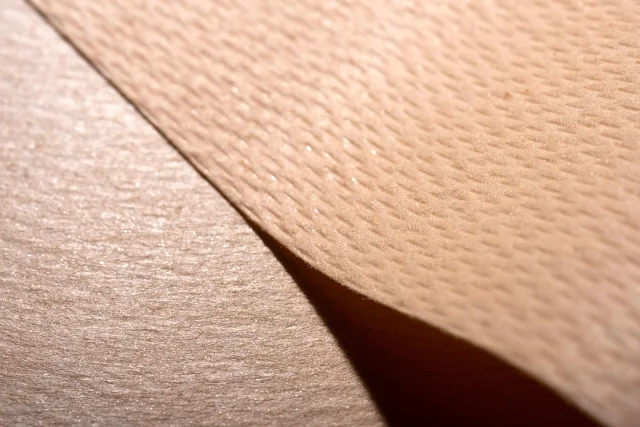Stretching the limits of melt-blown fabric

When we hear the word melt-blown, immediately we visualize a thin non woven used in a mask. Many of us are also aware that it is primarily made from Polypropylene (PP).It is normally supported by one or more spun-bond or melt-blown layer, but in general it is not stretchable and fragile to handle.
But what if there is a melt-blown fabric which can stretch, recover and is strong enough to make clothing out of it. This is possible by making melt-blown from TPU.
What is TPU melt-blown fabric?
TPU melt-blown fabric is a nonwoven fabric made of thermoplastic polyurethane (TPU) fibers. It is manufactured by extruding TPU polymer through a die with many small holes. The polymer is then blown with hot air to form fine fibers, which are collected on a conveyor belt.
What resins can be used to make TPU melt-blown fabric?
The most common resins used to make TPU melt-blown fabric are aromatic TPU and aliphatic TPU. Aromatic TPU is more resistant to chemicals and solvents, while aliphatic TPU is more resistant to UV light and hydrolysis. Fabric with various hardness can be made using different grade of TPU ranging from 70 Shore A up to 75 Shore D.
How is TPU melt-blown fabric manufactured?
The manufacturing process of TPU melt-blown fabric is similar to that of other melt-blown fabrics. However, there are a few key differences. First, TPU has a higher melting point than other polymers used for melt-blown fabrics, such as polypropylene (PP). This means that the extrusion and blowing processes must be operated at higher temperatures. Second, TPU is more viscous than other polymers used for melt-blown fabrics. This means that the die and blowing air pressure must be optimized to produce fine fibers.
What are the unique properties of TPU melt-blown fabric and why?
TPU melt-blown fabric has a number of unique properties, including:
- High elasticity: TPU is a very elastic material, so TPU melt-blown fabric has a high degree of stretch and recovery. This makes it ideal for applications where flexibility is required, such as medical dressings and sportswear.
- High breathability: TPU is a breathable material, so TPU melt-blown fabric allows air and moisture to pass through easily. This makes it ideal for applications where breathability is important, such as masks and filters.
- Water Repellence: TPU has natural water repellence, which as a nonwoven fabric gives the feature of low liquid absorption and quick drying.
- Good barrier properties: TPU is a good barrier to liquids and gases, so TPU melt-blown fabric can be used to protect against contamination and allergens.
- Heat Sealing / Bonding: TPU melt-blown fabric can be heat-pressed. In fact, it is often heat-pressed to bond it to other materials, such as fabrics and foams.
The unique properties of TPU melt-blown fabric are due to the chemical structure of TPU. TPU is a segmented polymer with alternating hard and soft segments. The hard segments are responsible for the elasticity and barrier properties of TPU, while the soft segments are responsible for its breathability.
How is TPU melt-blown fabric different from PP melt-blown fabric?
TPU melt-blown fabric and PP melt-blown fabric are both nonwoven fabrics made from melt-blown fibers. However, there are a number of key differences between the two fabrics.
- Elasticity: TPU melt-blown fabric is highly elastic, while PP melt-blown fabric is not.
- Breathability: TPU melt-blown fabric has good breathability, while PP melt-blown fabric has poor breathability.
- Barrier properties: TPU melt-blown fabric has good barrier properties, while PP melt-blown fabric has poor barrier properties.
- Cost: TPU melt-blown fabric is more expensive than PP melt-blown fabric.
Unique applications for TPU melt-blown fabric
TPU melt-blown fabric can be used in a variety of applications, including:
-
Medical dressings: TPU melt-blown fabric is used to make medical dressings that are flexible, breathable, and waterproof.
-
Masks and filters: TPU melt-blown fabric is used to make masks and filters that are effective at blocking bacteria, viruses, and other contaminants.
-
Sportswear: TPU melt-blown fabric is used to make sportswear that is flexible, breathable, and comfortable.
-
Protective clothing: TPU melt-blown fabric is used to make protective clothing that is resistant to chemicals, solvents, and other hazardous materials. One unique application for TPU melt-blown fabric is in the production of elastic medical tape. This type of tape is used to secure dressings and bandages in place. It is also used to provide support and compression for muscles and joints. TPU melt-blown fabric is a versatile material with a wide range of potential applications. It is particularly well-suited for applications where elasticity, breathability, and barrier properties are important.
Innovate with Kamlatech